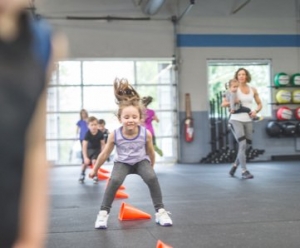Now Is the Time to Bring Back the Presidential Fitness Test

I am not sure about you, but over the last few years I have noticed a seriously sharp decline in the resiliency of our children. No longer are they able to tolerate stress, face adversity, and handle any sort of criticism.
While I don’t doubt that this is the result of a combination of factors, I cannot help but feel the cancellation of the Presidential Fitness Test may have played a role.
History of the presidential fitness test
The presidential fitness test all started with a warning from a man by the name of Dr. Hans Kraus all the way back in 1953.
Kraus, a specialist in physical medicine, published a paper with another specialist (Dr. Prudden) warning that the affluent lifestyle many American children were currently living was causing them to become complete and utter ‘couch potatoes.’
Out of interest, both researchers started running children from different countries through a specific fitness test – and they found that in European countries were children were incredibly active, very few failed (~8%).
However, when this same test was brought to America, the fail rate was a whopping 58%.
Kraus and Prudden then took their findings to Washington, and on July 16, 1956, President Eisenhower issued an Executive Order that led to the creation of the “President’s Council on Youth Fitness” – which is now the “President’s Council on Physical Fitness, Sports and Nutrition.”
This council promoted physical fitness for all children, and subsequently called for the involvement of community organizations, schools, and researchers to find specific ways of increasing physical activity levels across the nation.
One of which was the Presidential Fitness Test.
This test initially included several activities that tested children’s fitness levels across a number of different domains:
- Shuttle run test
- 50 year dash
- 500 yard run (later changed to a half mile run)
- Maximum Pull ups (boys), or best arm hang (girls)
- Long jump
- Maximum sit up test
- Sit and reach test
Finally, those children that scored within the 85th percentile of these activities was awarded the presidential fitness award.
Now, while this test was a core component of the curriculum for close to 50 years, it was eventually scrapped after the 2012-2013 school year.
John F Kennedy US physical fitness program
This leads quite nicely into the top of John F Kennedy’s Physical Fitness program.
As outlined above, the late 1950s lead to the roll out of mass physical testing for American school children. Within this, a large part of JFK’s election campaign revolved around the premise of increasing the nation’s health.
Subsequently, upon his election in 1961, JFK and his team created a US physical fitness program designed with the intent to boost the health of the nation’s school children.
While schools were not forced to participate, this program was offered to schools across the nation, and almost 250,000 school children took part in pilot projects to measure its effectiveness.
This program included the following to be performed daily if possible:
Conditioning exercises:
- Bend and Stretch 10 reps
- Knee Lift 10 left, 10 right
- Wing Stretch 20 reps
- Half Knee Bend 10 reps
- Arm Circles 15 each way
- Body Bend 10 left, 10 right
- Prone Arch 10 reps
- Knee Push up 6 reps
- Head and Shoulder Crawl 5
- Ankle Stretch 15 reps
Circulatory exercises:
- Walking 1/2 Mile
- Rope (Skip 15 secs, Rest 60 secs) 3 series
As simple as this protocol was, they found that those schools that implemented it saw huge improvements in the fitness test results of their children. Interestingly, this came with the suggestion that those also saw significant increases in their academic achievements as well.
In short, it was a raging success.
And with this success came expansion, where over time, new programs and awards were added by later administrations – right up until the end of the program, in 2013.
Why did they get rid of these programs?
So, if this program was such a significant success, why was it scrapped.
Well, in short, it came down to something some people have termed kid shaming.
The idea of the program was to motivate kids to get in shape and improve their health. This was further enforced by providing those children who finished in the top 15% with awards highlighting their achievements.
But people argued that this approach only supported those children who were already fit and athletic.
In this manner, it was suggested that it ultimately forced unathletic kids to try and fail in front of their entire class – which would only lead to shame and humiliation.,
People begun to believe that instead of encouraging these kids to reach for attainable health and fitness goals, it made them hate and physical fitness and exercise.
And maybe this was true for a very small percentage of the population – but does that mean getting rid of it was the right thing to do?
How obesity in America has grown
Obesity is defined as abnormal and excessive fat accumulation, presenting a risk to health.
It is determined by a measure known as body mass index (or BMI for short). Your BMI is calculated by dividing your weight in kilograms, divided by the square of your height in meters.
For example, if you were 85kgs and 1.82 meters tall, then your BMI would equal 25.7.
Calculate your BMI:
BMI
Now, going back to our original point, someone is classified as being obese when their BMI becomes more than 30 (A normal BMI is 18.5 to 24.9). Someone is classified as being overweight if their BMI sits within 25.0 and 29.9.
It is well established that obesity is a major risk factor for several chronic diseases, including diabetes, cardiovascular diseases, and even cancer.
Incredibly, since 1965, the incidence of obesity in our adult population has increased from 12% all the way up to 40% in 2019. Within this, more than 30% of children aged between 2 and 17 are also classified as either being overweight or obese – and this is only set to rise in the future.
In short, childhood obesity is becoming a major problem, and something needs to change – and it should start with our school system.
Related Article: Does Obesity Increase Your Risk of Coronavirus?
What are US schools doing now for physical fitness?
These US physical activity guidelines for children state (US Department of Health and Human Services, 2008) that:
- Children should get 60 minutes or more of physical activity daily.
- That most of this 60 minutes should be comprised of either moderate or vigorous intensity aerobic activity
- That they also participate in physical activity that places a priority on the strengthening of muscle and bone at least 3 times per week.
They also finish the guidelines with the following statement:
‘it is important to encourage young people to participate in physical activities that are appropriate for their age, that are enjoyable, and that offer variety.’
Now this is where things start to get a little bit scary (Perna, 2012).
The amount of exercise children get at school through physical education class sits somewhere between 65 and 105 minutes per week. This obviously varies depending on location and state legislation, but wither way, it is nowhere near enough.
In my mind, this clearly shows that modern day schools are not doing anywhere near enough to ensure the health of our children.
Inactivity impairs self-esteem
While we are on the topic of inactivity, I wanted to highlight one important factor that is often forgotten – and it refers to self-esteem.
If we think back to the president’s fitness test – and more importantly, the reason it was scrapped – is because of the shame it caused. I would further argue that the biggest concern was that this sense of shame would lead to irreversible declines in self-esteem.
But this may be counterintuitive to the true narrative (Lie, 2015).
There is a large body of evidence clearly demonstrating that those children who perform more exercise have higher levels of self-esteem and self-worth than those who are inactive. Furthermore, if you get children who are inactive to increase their activity levels, they see a rise in self-esteem.
How physical fitness promotes self-esteem
Why does this occur (Reddon, 2017).
Well, exercise has been shown to promote the development of positive self-worth, self-esteem, social support systems, and self-efficacy. It has also been shown to have a physiological effect on the body, where it increases neural plasticity and hormone function.
Finally, we also see some important psychological changes.
When children perform exercise with other children, they develop multiple self-identities, each with their own affinity that vary based on the diverse social and relational roles that occur within this important developmental stage.
In essence, activity allows children to thrive in numerous social situations – which is extremely important for the development of self-worth, and resiliency.
The government is not going to save our children
Looking at the above information, it is obvious that the government are not doing enough to ensure the health and wellbeing of our children – and the responsibility lies with us.
This means making sure that we integrate vigorous physical activity int our child’s daily routine. It means pushing them out of their comfort zones. Allowing them to climb trees and get their knees dirty unsupervised. Play sports that they may not be all that good at.
Hell, it may even mean throwing away those useless participation trophies.
Ultimately it means promoting physically and mentally challenging activities to develop them into healthy, resilient, human beings.
Related Article: How to Build Resiliency During A Pandemic
Take Home Message
Despite some potential downfalls, the Presidential Fitness Test had a significant impact on the health, wellbeing, and resiliency of our children. Something that has been on a steady decline since it was scrapped in 2013.
This means that it is up to us to make a difference.
What have you been doing to help your children become strong resilient people? Let us know in the comments because we would love to hear from you.
References
US Department of Health and Human Services. “2008 physical activity guidelines for Americans.” http://www. health. gov/paguidelines/ (2008).
Perna, Frank M., et al. “The association of state law to physical education time allocation in US public schools.” American journal of public health 102.8 (2012): 1594-1599.
Liu, Mingli, Lang Wu, and Qingsen Ming. “How does physical activity intervention improve self-esteem and self-concept in children and adolescents? Evidence from a meta-analysis.” PloS one 10.8 (2015).
Reddon, Hudson, David Meyre, and John Cairney. “Physical Activity and Global Self-worth in a Longitudinal Study of Children.” Medicine and science in sports and exercise 49.8 (2017): 1606-1613.
You Might Like:



















